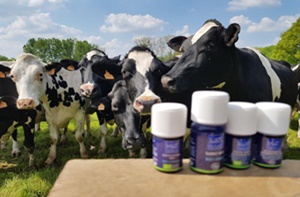Effet d'un additif alimentaire naturel riche en huile essentielle de thym sur les émissions de méthane chez les vaches laitières
Résumé
L’objectif de ce travail consiste à évaluer l’effet de l’addition à la ration alimentaire, d’un additif alimentaire naturel riche en huile essentielle de thym sur la quantité de méthane émise par les vaches laitières. Le méthane est à la fois un puissant gaz à effet de serre et une vraie perte énergétique pour les ruminants. Sa réduction est bénéfique pour les animaux et pour l’environnement. Afin de tester l’effet de cet additif alimentaire naturel riche en huile essentielle de thym sur l’émission du méthane par les vaches laitières, cinq vaches de race croisées Holstein ont été utilisées, la ration alimentaire quotidienne est composée de 4 kg d’aliment concentré industriel, 2 kg de foin de luzerne et 2 kg de paille de blé. Après une adaptation de deux semaines au régime alimentaire, des mesures de la production du méthane ont été réalisées. Ensuite, 50 g du produit riche en huile essentielle de thym ont été ajoutés quotidiennement à la ration de base (soit 7,15 g/kg MS), et après deux semaines d’adaptation, une deuxième mesure du méthane a été effectuée. Un troisième essai a été réalisé en ajoutant 100 g du même produit à la même ration de base (soit 14,3 g/Kg MS), et une troisième mesure de méthane a été réalisée après les deux semaines d’adaptation. La quantité journalière de méthane produite par les cinq vaches a été estimée à environ 195,9 l/j. L’addition du produit riche en huile essentielle de thym à la ration de base a été à l’origine d’une réduction de méthane produit en moyenne de 21,6% lorsque le produit a été ajouté à la dose de 7,15 g/kg de matière sèche et de 31,8% à la dose de 14,3 g/kg de MS.
Mots clés: Additif alimentaire, Production du méthane, Huile essentielles de thym, Vache laitière, Effet de serre.
Téléchargements

Publié-e
Comment citer
Numéro
Rubrique
Licence

Revue Marocaine des Sciences Agronomiques et Vétérinaires est mis à disposition selon les termes de la licence Creative Commons Attribution - Pas d’Utilisation Commerciale - Partage dans les Mêmes Conditions 4.0 International.
Fondé(e) sur une œuvre à www.agrimaroc.org.
Les autorisations au-delà du champ de cette licence peuvent être obtenues à www.agrimaroc.org.

